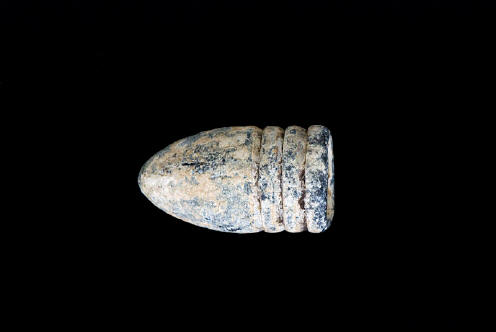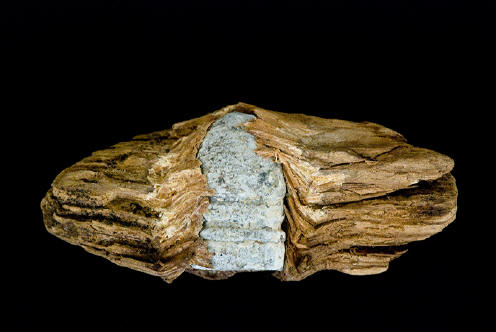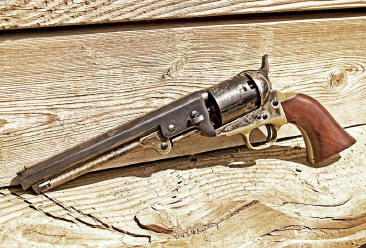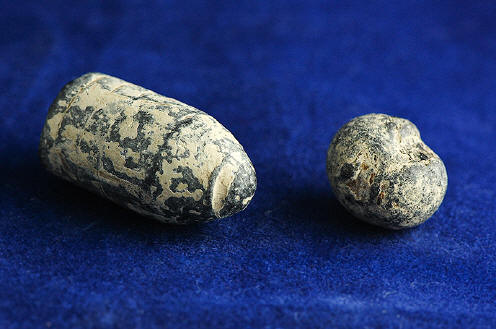| |
Bullets/Civil War Relics
 |
Gettysburg Pickett's Charge Relic
3-Ringer Minie Civil War relic
recovered on the Codori Farm in Gettysburg. This relic was found on private
property by the property owner. It was part of the Frederick Collection,
1917-1989. It was owned by Frederick McCullough who had a cousin, William
McCullough of Gettysburg, who owned a bookshop in Gettysburg in the early
1900's. Every item in the Frederick Collection was individually wrapped and
cataloged by the original owner including recovery location, description and
the date. This item was recorded as GB503R, Codori Farm, Gettysburg,
Pickett's Charge, August 20, 1924.
The Codori Farm was part of the land the soldiers crossed during Pickett's
Charge on July 3, 1863. This relic was in the hands of a brave soldier on
that fateful afternoon. Pickett's Charge was the turning point and is the
most significant battle of the war. The piece shows the normal oxidation
associated with relics in the area and of the time. Gettysburg relics of
this type that have excellent provenance are becoming harder to find every
day. This relic came with 1) a sealed & signed Certificate of Authenticity,
2)photographs of the recovery site, 3) maps and 4) a Letter of Provenance.
|
|
2 CARVED CIVIL WAR BULLETS
Two Civil War soldier carved bullets.
The smaller one looks like a game piece - possibly a rook for chess. The
other might have been intended as a game piece as well. The location where
they were found is unknown. These were acquired from the Civil War
collection of Henry Deeks. They came with a signed letter noting this
provenance. Bullet carving was a
common pastime during long waits in camp.
|

|
|
 |
Bullet in wood from Battle of
White Oak Road, Virginia
March 31, 1865
This is a Civil War bullet in wood
which is from the battle of White Oak Road, Virginia found with the
permission from the landowner. This bullet is a 54 cal. US Sharps.
The Sharps Rifle was used in the Civil War by the U.S. Army sharpshooters
known popularly as "Berdan's Sharpshooters" in honor of their leader Hiram
Berdan. The Sharps made a superior sniper weapon of higher accuracy than the
more commonly issued muzzle-loading rifled-muskets. This was due mainly to
the higher rate of fire of the breech loading mechanism and the fact that
the quality of manufacture was superior. It was produced by the Sharps Rifle
Manufacturing Company in Hartford, CT.
|
|
SPENCER CARBINE
BULLET FROM GEORGE CUSTER CAMPSITE
This is a Spencer carbine
bullet dug from the Civil War campsite of General George A. Custer, near
Middletown, VA. Scene of the Battle of Cedar Creek.
My great grandfather, Peter,
fought in The Battle of Cedar Creek, October 19,1864. It was also the site
where my great grand uncle, Kieran, was killed on that date. Details on
them at: http://creekbed.org/horan/
The Spencer repeating rifle
was a manually operated lever-action, repeating rifle fed from a tube
magazine with cartridges. It was adopted by the Union Army, especially by
the cavalry, during the American Civil War, but did not replace the standard
issue muzzle-loading rifled muskets in use at the time. The Spencer carbine
was a shorter and lighter version.
The design was completed by
Christopher Spencer in 1860, and was for a magazine-fed, lever-operated
rifle chambered for the 56-56 Spencer rimfire cartridge. Unlike later
cartridge designations, the first number referred to the diameter of the
case at the head, while the second number referred to the diameter at the
mouth; the actual bullet diameter was .52 inches. Cartridges were loaded
with 45 grains (2.9 g) of black powder.
http://en.wikipedia.org/wiki/Spencer_repeating_rifle
|

|
|

|
BUCKLE from a Civil War
Kepi Hat, Dug Relic from Petersburg VA
The first official version of the Kepi hat was introduced for
the U.S. Army in 1858. It was rather baggy in dark blue. It gave rise to a number of methods of wearing, most
of which looked unmilitary. Officially called a forage cap, it was nicknamed
'bummers cap' by troops, being described as being 'shapeless as a feedbag'.
Despite this, it became the most common form of cap worn by U.S. regulars
and volunteers during the American Civil War and is characterized in films
such as Gettysburg, Gods and Generals and Glory. It was also worn by many
Confederate troops in dark blue, various shades of grey and butternut. A
famous wartime commander who habitually wore this cap was Confederate
General Thomas J. "Stonewall" Jackson, who wore his plain dark blue round-visored
forage cap, a reminder of his days as a former instructor at the Virginia
Military Institute, until it was almost falling apart. He was subsequently
presented with a new grey forage cap, with gold braid, which he was wearing
when he was mortally wounded on the first evening of the battle of
Chancellorsville on May 1, 1863.
Petersburg was the site of another battle that
my great grandfather attended on April 2, 1865.
This buckle held a strap around the middle and
is roughly 7/8" x 3/4"
|
|
1851 Colt Navy Handgun - Reproduction
The Colt 1851 Navy was the most popular
six-gun in America up to 1873 when the Peacemaker was developed. The gun was
used extensively in the Civil War and later by such notables as James Butler
"Wild Bill" Hickcock. The gun design was adopted by the confederate army
though because of metal shortages, they had to use a weaker brass frame.
Robert E. Lee carried one but when it was fired after the war, it
chain-fired, which is to say that all 6 cylinders accidentally fired at
once.
The development of handguns in the last half of the 19th century is
sometimes compared to the development of the computer in the 20th. New
models were constantly being developed and competition between different
companies was intense. Because of numerous attempts to counterfeit the 1851,
Colt came up with a form of copy protection that is similar to Microsoft
hologram that they print on their software boxes. Colt used an engraved
cylinder that was difficult for the imitators to reproduce and was proof
that you owned an original Colt handgun. The engraving depicts a battle
between the Texas and Mexican navies on May 16, 1843. |

|
|

|
GETTYSBURG EARLY PICK UP
DROPPED BULLET FROM THE SHIELDS MUSEUM
This three ring bullet has
almost no patina indicating a very early battlefield find. It was a part of
the Shields Museum collection. The Shields Museum was a Gettysburg Museum
established by Arthur Shields in 1925 to house Gettysburg items. After it
was closed, the collection was sold at auction on November 16, 1985. This
was a well-known museum and collection, items from which are becoming
increasingly difficult to find. It came with a signed letter guaranteeing
that this bullet was purchased at the Shields Museum auction with the
accompanying lot number. I also included a copy of the original auction
advertisement, a copy of the first page of the auction list, and a copy of a
newspaper article relating to the original auction. |
|
Original Civil War Era Bone or
Ivory and Ebony Domino
8/4 from a set of Double 9 Dominoes. The
Double 9 sets were quite uncommon during Civil War times, but where around
in small quantities. Most sets were Double 6 sets.
The soldiers often played Dominoes (and other games) in camps between
battles.
Center pin is good and solid.
Notice the lack of uniformity between the dots.
Nice aged patina and great character.
The size of the domino is a approximately 1.46" X .72" X .26" thick.
Dominoes with one pin in the center are more commonly associated with the
South. Dominoes with 2 or 3 pins were mostly northern.
|

|
 |
Group Of Twelve Civil War
Ground Recovered Soldier Pipes
Civil war pipes from the
Vicksburg Mississippi area. They come from private land and were found in a
union camp trash pit that is on private land. Originally purchased from the
digger at the Memphis civil war show, winter of 2008.
In the 17th and 18th Centuries thousands of
clay pipes came to the New World and many fragments are still being found in
the soil of the earliest settlements. Pipe shards and some intact clays have
been excavated on Civil War battlefields and in encampments in great numbers
showing the strong presence of clay pipes in the 1860s among the soldiers
who fought on both sides. "The Clay" remained king at least among men until
the later part of the 19th Century.
The first clay pipes were
introduced to Europeans along with tobacco smoking by the Native Americans
of South and North America. It was not long before clay pipe making became
an established trade. Later mass produced European and American clay
pipes became a trade item and were bartered back to Native American tribes!
Clay pipes can be repaired
with the quill of a turkey or goose as a stem!"
These are ground recovered pipes so they are
all missing parts of their stems and have some damage. In the period when
pipes where made of pipe clay the owner would snap off a small portion of
his pipe as he smoked because the end would become bitter.. He
would do this until he came to the "bitter end". This is why for the most
part you will not find ground recovered pipes in good condition.
The information above came from James E. Boyle &
Beth Maxwell Boyle
Thistledown Croft |
|
Peach Orchard |

|
|

|
1864 INDIAN HEAD PENNY
Confederate coin, Confederate disk button
and Confederate pistol ball. |
|
Civil War Era Effigy Trade Pipe |

|
| |
|
Useful
Resources
|
|
|

Authentic
Artifact
Collectors
Association
______
Overstreetid.com
The Official Overstreet Indian
Arrowhead Identification Online Database
______
|
|
|
|
|
|
|